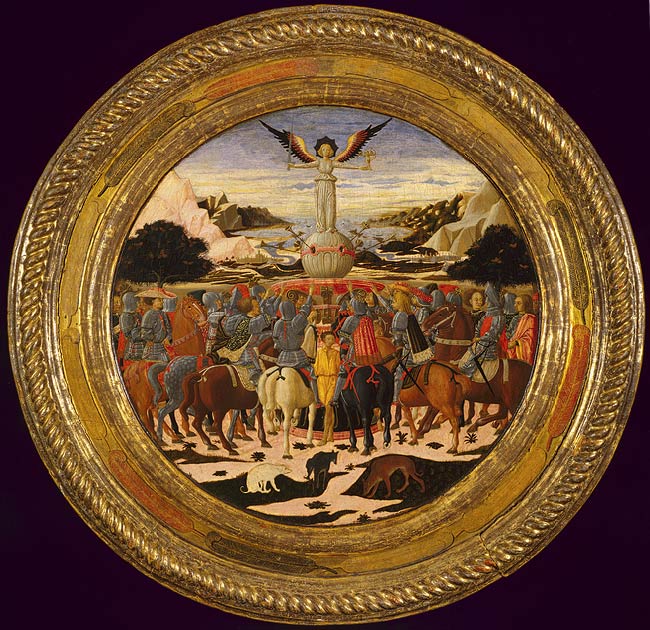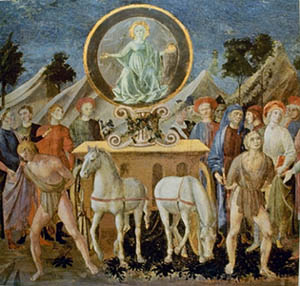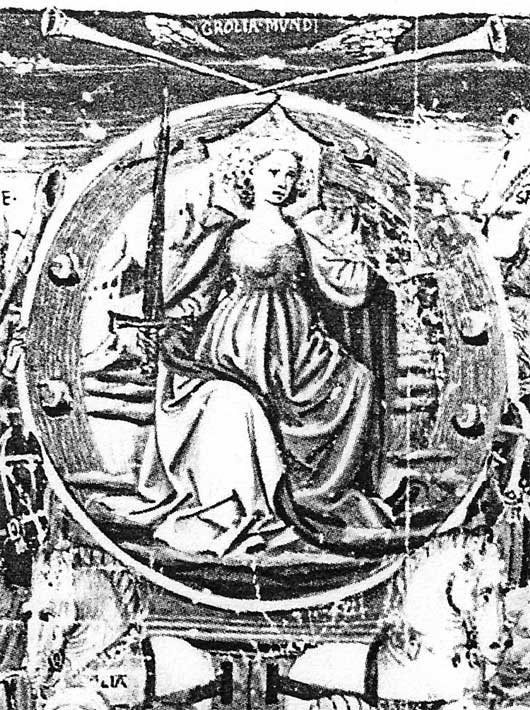Regarding the halos, particularly the halo on the Charles VI World card, I found that in depictions of the Triumph of Fame, from 1449 to 1460 in Florenence (from what I've found), the figure of Fame is frequently shown with the polygonal halo.
Birthtray of Lorenzo di Medici (Giovanni di Ser Giovanni), 1449 -
(article to this at the Met. Museum
http://www.metmuseum.org/toah/ho/08/eustc/ho_1995.7.htm )
A Triumph of Fame by Pesellino (he worked from 1422-1457, Florentine)
http://www.italica.rai.it/rinascimento/iconografia/prot_1095.htm
text -
http://www.italica.rai.it/rinascimento/categorie/fama.htm
Another, also attributed to Pesellino -
http://www.artnet.com/artist/686022/francesco-di-stefano-pesellino.html
Finally, one by Apollonio di Giovanni (Florentine, c. 1415-1465)
This last one is part of six illustrations for Petrarch's triumphs, dated to around 1460. They can be seen in color at the Riccardiana site, where the manuscript is kept - I can't link directly to the page, since it's some kind of Flash reader page, but follow these directions (you *must* see it as they present it, it is well worth it)
***edited to add: Robert has kindly found and posted the entire image in post #36 above***
Go to -
http://miniature.riccardiana.firenze.sbn.it/sistema_ricerca.asp
in the right hand search menu, under "Miniatore", type "Apollonio".
You will get four (4) pages of image-links (most of the pages are Virgil illustrations).
Go to page 4; the Petrarch Trionfo images are the last 6; Fame is image number 92.
Click on the little magnifying glass/sheet of paper.
(note the mispelling - "GROLIA" for "GLORIA")
Apollonio also did allegories of the Virtues, and uses the same polygonal halos -
Fortitude
Prudence
This style of halo is strongly (uniquely perhaps?) associated with Florence, with the Virtues, and as Michael has shown, goes back to the early 14th century in that city. Some of the figures seem modeled on the Baptistry doors. But no one has noted the halo's use on the allegory of Fame in depictions of the Triumphs before, that I know.
Not on the other allegories of Triumphs however - only the Virtues and Fame.
Ross
(edited to add - those last two links are too long I guess. I'll have to go rename them, etc. Until then, just google Apollonio di Giovanni in images, they're among his works that come up)













